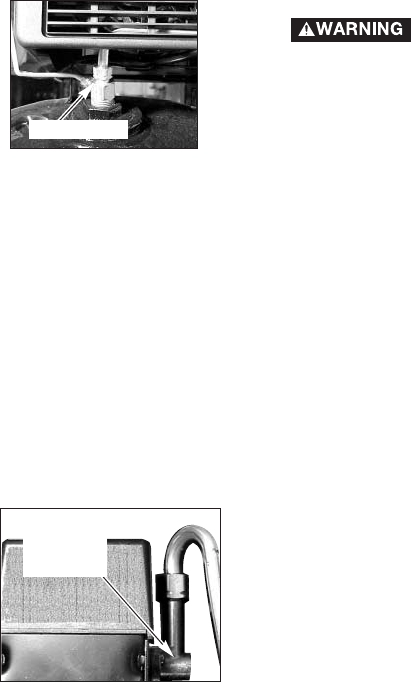
14- ENG
D25050
Check Valve: When the air
compressor is operating, the check
valve is “open”, allowing compressed
air to enter the air tank. When the air
compressor reaches “cut-out”
pressure, the check valve “closes”,
allowing air pressure to remain inside
the air tank.
Pressure Release Valve: The
pressure release valve, located on the
side of the pressure switch, is
designed to automatically release
compressed air from the compressor
head and the outlet tube when the air
compressor reaches “cut-out”
pressure or is shut off. The pressure
release valve allows the motor to
restart freely. When the motor stops
running, air will be heard escaping
from this valve for a few seconds. No
air should be heard leaking when the
motor is running, or continuous
leaking after unit reaches “cut-out”
pressure.
Air Intake Filter (not shown) This
filter is designed to clean air coming
into the pump. This filter must always
be clean and ventilation openings
free from obstructions. See
"Maintenance".
Pressure
Release
Valve
Check Valve
How to Use Your Unit
How to Stop:
1. Set the On/Auto/Off lever to
“OFF”.
Before Starting
Break-in Procedure
Serious damage
may result if the
following break-in instructions are
not closely followed.
This procedure is required before the
air compressor is put into service and
when the check valve or a complete
compressor pump has been
replaced.
1. Make sure the On/Auto/Off lever
is in the "OFF" position.
2.
Recheck all wiring. Make sure
wires are secure at all terminals
connections. Make sure all
contacts move freely and are not
obstructed.
3. Open the globe valve fully to
permit air to escape and prevent
air pressure build up in the air
tank during the break-in period.
4. Move the On/Auto/Off lever to
"ON/AUTO" position. The
compressor will start.
5. Run the compressor for 15
minutes. Make sure the globe
valve is open and there is
minimal air pressure build-up in
tank.
6. Check all air line fittings and
connections/piping for air leaks
by applying a soap solution.
Correct if necessary. NOTE:
Minor leaks can cause the air
compressor to overwork,
resulting in premature breakdown
or inadequate performance.


















